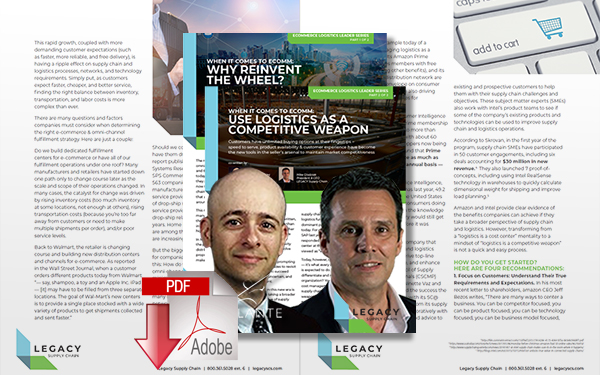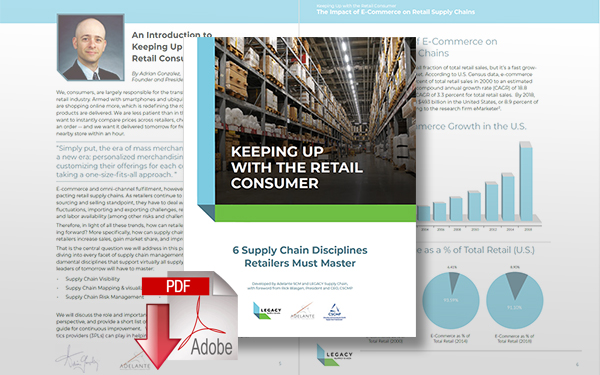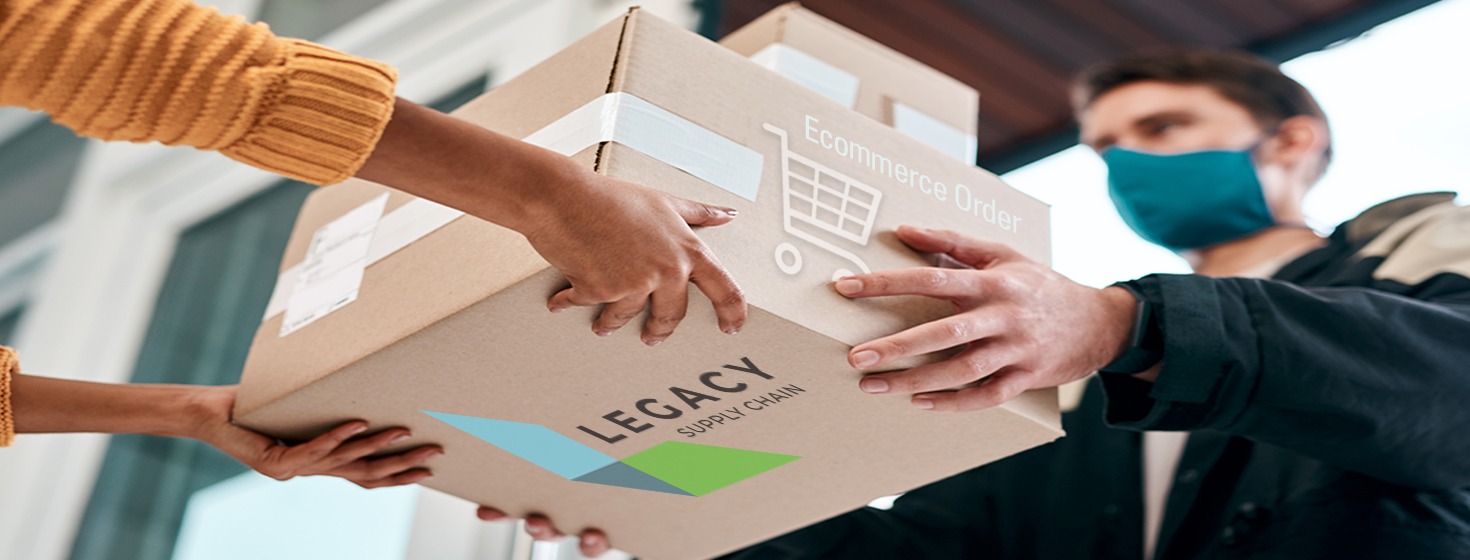7 Last Mile Logistics Delivery & Ecommerce Trends You Don’t Want to Overlook

The quarter's eCommerce performance was more muted as Amazon Prime Day dollars shifted to Q3 this year, and the increase in digital sales outpaced that of stores for the first time since early 2021, and more than 20% of consumer spending from April-June occurred online.
US Ecommerce Grows 7.3% in Q2 2022
As reported by Digital Commerce 360, U.S. eCommerce spending in Q2 marked its fourth straight quarter of single-digit growth following the 45%-50% jumps during the first year of the pandemic, according to a Digital Commerce 360 analysis of U.S. Department of Commerce figures released Friday. But the year-over-year increase in online sales also outpaced that of stores for the first time since early 2021.
The dramatic increase in numbers, which is consistent with increases in previous years, has many wondering when - not if - eCommerce will overtake physical retail. If some reports are to be believed, it could happen as soon as 2024.
There can be little wonder why eCommerce has surged in popularity: When it comes to convenience, nothing beats clicking a button to order an item and have it shipped directly to your doorstep. Add to that the fact that the ongoing COVID-19 pandemic has created a new housebound economy, and it’s likely that eCommerce will remain dominant for years to come.
The growing demand for eCommerce and rising consumer expectations have placed additional pressure on retailers to expedite delivery without increasing costs. This has brought renewed attention to order fulfillment, especially last-mile delivery.
What is Last Mile Delivery?
Last mile delivery, also known as final mile delivery or final mile logistics, refers to the transportation of goods from a warehouse or distribution center to their final destination - typically, the customer’s doorstep.
Last Mile Delivery During the COVID-19 Pandemic
Despite initial fluctuations in demand, the COVID-19 pandemic has only accelerated the growth of eCommerce. According to data from Adobe Analytics, eCommerce sales were up 55% year over year for the first seven months of the year, resulting in $434.5 billion in online spending. Adobe Analytics also predicted that 2020 online sales would surpass the total online sales in 2019 by October 5, 2020.
Much of this spending can be attributed to the fact that many consumers turned to retail therapy to alleviate pandemic-induced anxiety, especially during initial stay-at-home orders. Add to that the fact that non-essential stores were closed for a considerable amount of time, making in-person shopping impossible, and it’s easy to see what made eCommerce so appealing. Although the volume of eCommerce sales has dipped as more stores have reopened, it’s clear that COVID-19 has created a new normal in terms of consumer shopping habits and last-mile delivery expectations.
Final Mile Logistics Challenges
Last-mile delivery is an integral component of the order fulfillment process but is often the most challenging to coordinate for a number of reasons. First and foremost, last-mile delivery is expensive. Between fuel, vehicle, and labor costs - as well as associated fulfillment and technology costs - the price of last-mile delivery really adds up.
And that’s before you factor in the competition from the Amazons of the world, which promise “free” same-day or next-day delivery. We put scare quotes around “free” because, as everyone knows, there’s no such thing as a free lunch - the customer may never see the expense, but someone has to pay for shipping, so retailers usually end up eating the cost. For these and other reasons, final mile logistics accounts for 53% of the total cost of shipping and 41% of total supply chain costs.
Once you get past the financial challenges of last-mile delivery, there are logistical challenges to consider. Unfortunately, last-mile distribution is affected by a number of variables, many of which are outside retailers’ control - for example, the customer’s location relative to the warehouse or distribution center, the number of deliveries along a carrier’s route, traffic while in transit, customer availability and so on. Oftentimes, final mile delivery requires coordination of time-definite delivery windows for installation or signoff in the case of controlled substance fulfillment. Other challenges, such as inventory shortages, discrepancies in order tracking, and routing errors can be attributed to process inefficiencies and an overall lack of transparency.
Final mile logistics has become a proving ground for many retailers. According to one survey, 59% of consumers say that they buy more and more frequently from retailers that offer fast, easy, and transparent delivery. Based on that same survey, 48% of consumers ages 18–26 have voiced their displeasure about a delivery experience on social media. If there’s one thing that’s clear, it’s that the last-mile delivery experience can easily make or break a retailer’s reputation.
“The final mile delivery when it comes to end consumer delivery is really supplying that end consumer with the experience they’re looking for,” said Louis DeJianne, UPS’ director of marketing for consumer goods, apparel, and retail.
“When that package is delivered, that package being delivered is still an extension of your brand.”
In light of this, many retailers have found creative and innovative ways to reduce costs, eliminate inefficiencies, provide greater transparency and optimize the entire last-mile distribution process.
Without further ado, let’s take a look at some of those last-mile delivery trends.
Read the Case Study: Full-Scale Supply Chain Solution for Large Canadian Retailer
7 of the Latest & Greatest Last-Mile Delivery Trends
1. The Gig Economy & Crowdsourcing
Venture capitalist startups such as Uber, Airbnb, and TaskRabbit have changed the labor market as we know it, contributing to the rise of the gig economy - and they’re coming for last-mile delivery, next. From Amazon Flex to Postmates to Roadie, a growing number of business units and companies have cropped up that provide crowdsourced delivery services.
“Crowdsourced delivery was not possible 10 or 15 years ago,” said Ingrid Bekkers, VP of Marketing at Deliv, a crowdsourced same-day delivery startup. Unfortunately, Deliv announced it was shutting down and Target Corporation announced plans to acquire Deliv's technology assets.
“There has been a profound technology shift for drivers. Today, everyone has a GPS computer in their pocket. With that, you can mobilize a disparate workforce of delivery drivers by a whole host of factors, chief among them is where they are.”
And it’s easy to understand the appeal: A crowdsourced delivery model can drastically reduce retailers’ out-of-pocket shipping costs, customers have the flexibility to schedule deliveries based on their availability, and GPS and/or telematics devices allow for real-time traceability.
That said, crowdsourcing last-mile delivery isn’t without its challenges. Though it’s really taken off in urban centers, where couriers on bicycles have an easier time navigating narrow, congested streets than traditional delivery vehicles, it has yet to see that same rate of adoption in rural areas. Additionally, there’s the concern that retailers have less oversight with crowdsourcing than they would with traditional delivery methods, meaning there’s greater potential for inefficiency.
2. Smart Technology for Tracking
Transparency and traceability are major concerns for retailers and consumers alike, but letting customers know the current status of their order and whether a package is en route to its final destination are just table stakes. What if you could tell customers the exact location of an item in transit with pinpoint accuracy? Even better - what if you could tell customers the exact environmental conditions in which their package is being delivered?
With smart technology, you can. From using GPS and RFID tags to track the movement of shipments in real-time to embedding IoT-enabled sensors in packages in order to monitor their temperature and humidity, smart technology has enabled retailers to provide their customer base with the transparency and traceability they desire. And smart technology isn’t limited strictly to consumers tracking in-progress shipments - retailers can even leverage it to monitor weather patterns and plot delivery routes in order to ensure that packages arrive at their final destination on time and in pristine condition.
3. Robotic Delivery
Of the various expenses associated with last-mile delivery, labor is the highest, accounting for an estimated 60% of costs. And when it comes to labor, the cost isn’t the only limiting factor - there’s also the matter of availability and schedule to consider. For these and other reasons, a growing segment of retailers is starting to experiment with robotic delivery in the form of self-driving vehicles, drones, and autonomous delivery bots.
Though this technology is still largely untested and unproven, it appears to be the way of the future, especially in a post-COVID-19 world. Just ask Amazon, which recently invested $530 million in the self-driving car company, Aurora. According to one Amazon spokesperson, “Autonomous technology has the potential to help make the jobs of our employees and partners safer and more productive, whether it’s in a fulfillment center or on the road, and we’re excited about the possibilities.” And as we all know, where Amazon goes, others will follow.
4. Rapid Order Fulfillment
Speaking of Amazon, the eCommerce behemoth is often credited for kickstarting the rapid order fulfillment revolution with its two-day (now one-day or same-day) Prime delivery. Although most businesses can’t afford to shell out the same amount of coin as Amazon to support this level of rapid order fulfillment - the company reportedly spends billions on shipping - it’s imperative that you make every effort to winnow down your last-mile delivery window in order to meet rising customer expectations. One efficient way to do this is to partner with a third-party logistics (3PL) provider that leverages a warehouse management system to optimize the order fulfillment process.
5. Urban Warehouses
The acceleration of eCommerce and the growing demand for rapid order fulfillment has also prompted a shift in the way retailers approach warehousing. Following in the footsteps of major players like Walmart, Target, and IKEA, a growing number of businesses are exploring the possibility of urban warehousing.
Read: How Does IKEA’s Inventory Management Supply Chain Strategy Really Work?
The idea is simple: The closer a fulfillment center is to the end consumer, the easier it is to reduce delivery lead time. Given the fact that the vast majority of consumers live in or around major metropolitan areas, building a warehouse within city limits can be a practical way to expedite final-mile logistics and fulfill same-day orders.
Another major benefit of urban warehousing is that it provides retailers with closer access to pools of labor. Like consumers, many warehouse employees live in or around city centers; rather than requiring those workers to drive out to suburban areas, urban warehouses bring work closer to home. This is even better for workers who do not own their own cars and would otherwise be dependent on public transit.
Urban warehouses are currently a hot commodity in short supply, however, a growing number of real estate developers are turning their attention to this expanding market. Innovo Property Group is one such firm, having recently broken ground on a one million square foot, two-story Class A logistics, and distribution facility in the Bronx.
“What’s interesting is that because of the confluence of factors - the demographic trend to live in cities, the smartphone, shorter delivery time frame requirements, and the advent of a shared services new economy, which focus on capacity utilization to drive down costs - has created a need for a totally new sector in real estate, which is the urban warehouse,” said Andrew Chung, Founder & CEO of Innovo.
“In addition to addressing shorter delivery times, [these facilities] can also accommodate multiple needs for the retailer.”
As the saying goes, “If you build it, they will come.” That’s certainly the hope of industrial developers and, given the last-mile delivery opportunities that urban warehouses present, it’s likely to come true. That said, new developments aren’t the only answer to the demand for urban warehousing: Major retailers are starting to explore the option of transitioning vacant storefronts in shopping malls into fulfillment centers.
6. Insourcing Deliveries
Rather than outsource last-mile delivery, some retailers have instead opted to handle everything internally, relying on their own fleet of vehicles or a hybrid fleet to fulfill orders. Although outsourcing remains the order of the day, some retailers have even chosen to co-op with competitors in their region to share assets and reduce final-mile logistics costs. This trend has inspired some 3PL providers to develop their own local delivery services to compete with insourcing, with vehicles and technicians on-hand for local deliveries.
7. Hybrid Fleet Management Systems
As mentioned, some retailers have adopted a hybrid fleet model - that is, a combination of a trucking company's own fleet, paired with contractors, third-party providers, and freelance drivers - in order to scale fleet size in accordance with changes in demand. A hybrid fleet model offers greater flexibility and affordability than the traditional model. If aligned correctly with your fleet operator, there are even more opportunities to create value-added synergies within your supply chain, including optimizing deliveries within your entire network, mitigating deadhead miles with empty trucks, and even introducing the potential to broker your truck capacity in certain lanes.
A hybrid fleet strategy requires a fleet management system capable of enabling efficient transportation execution. Similar to traditional fleet management systems, which enable businesses to gain insight and analytics into vehicle and technician performance, a hybrid fleet management system provides you with a centralized dashboard from which you can optimize routing, monitor vehicle location, receive delivery updates and weather alerts, access historical reports and more, all in real-time. With a hybrid fleet management system, you get the best of both worlds in terms of both scalability and control, making it one of the leading trends for last-mile delivery today.
Closing Thoughts
As we look to the future, we expect the continued growth of the eCommerce market and, with it, increased demand for fast and efficient last-mile delivery.
To find out how to incorporate these and other final mile logistics trends into your eCommerce fulfillment strategy, talk to the experts at Legacy Supply Chain. With over 30 years of experience delivering full-service logistics to leading retailers, manufacturers, wholesalers, and distributors, we have the expertise to help you develop a winning final-mile delivery strategy. Contact us today to talk to one of our specialists.
About the Author
Kyle Krug has 20 years of professional experience in marketing & strategy, technology & information management, business development, and operational support positions in B2C and B2B services industries. Kyle Krug leads Marketing & Communications for LEGACY Supply Chain Services, with past roles as the Director of Client Solutions for Griffin Global Logistics, and Marketing Manager/Data Analyst in the Hotel Casino industry.
Related Resources
Supply Chain Ecommerce Logistics Leader Series
Co-written by Adrian Gonzalez, president of Adelante SCM, and Mike Glodziak, president & CEO of LEGACY Supply Chain Services, this ecommerce logistics leader series describes how you can get to market faster, by leveraging your existing network, resources, and relationships to their fullest potential as well as how you can use logistics as a competitive weapon. Download Now!
Keeping Up with the Retail Consumer
6 Supply Chain Disciplines Retailers Must Master - Developed by Adrian Gonzalez, Founder and President of Adelante SCM and LEGACY Supply Chain Services, with a foreword from Rick Blasgen, President and CEO, of CSCMP. Download Now!
More Resources from Legacy Supply Chain
Related Article: Ecommerce Order Fulfillment - 7 Last-Mile Delivery Trends to Help Develop a Winning Strategy





















